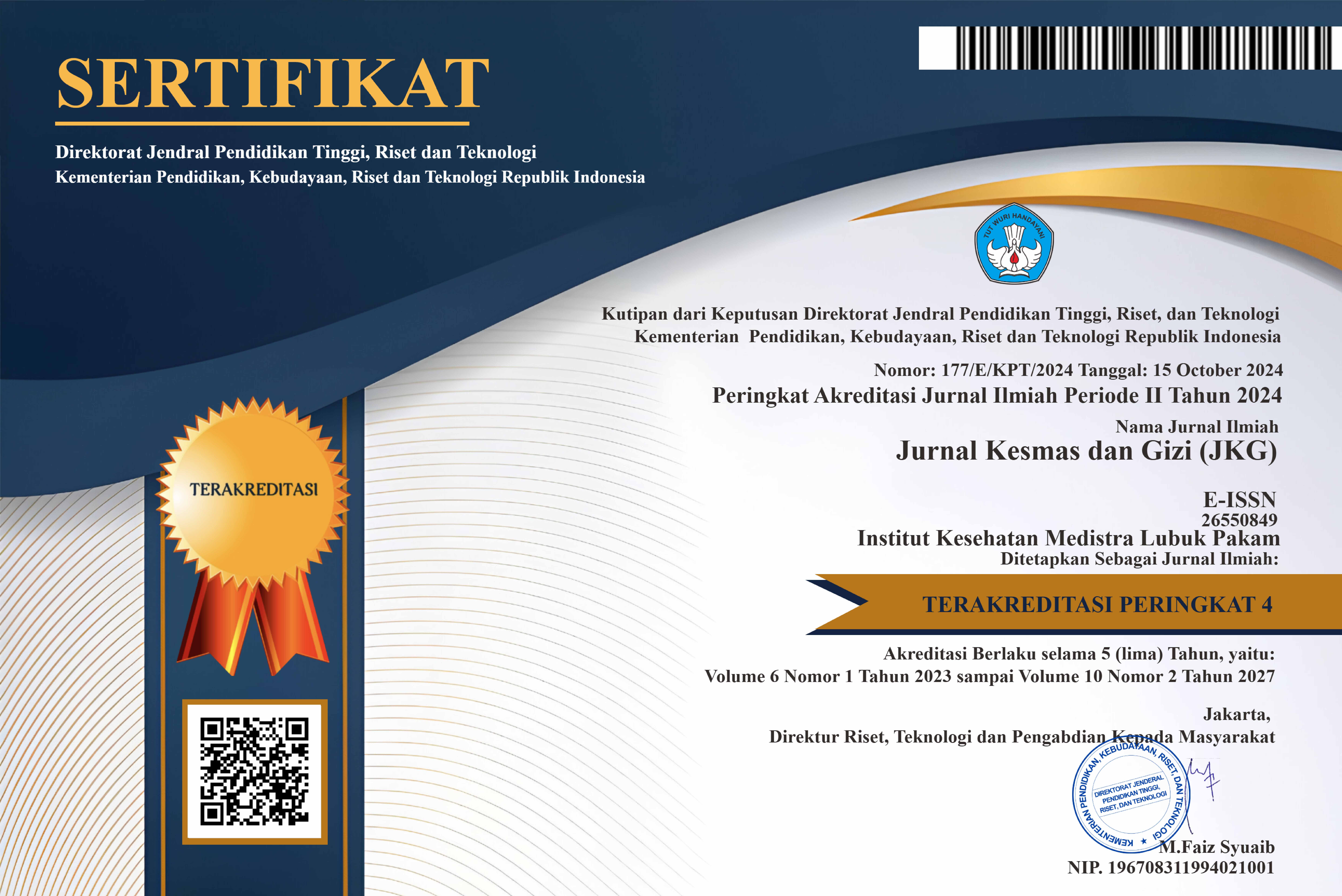Standardized Nutritional Care Process Management Of Pediatric Patients With Congenital Heart Disease And Malnutrition
DOI:
https://doi.org/10.35451/jkg.v7i2.2711Keywords:
congential heart disease, malnutrition, nutrition careAbstract
Congenital heart disease can be experienced early in life. This disorder can cause growth disorders in children, one of which is malnutrition. Malnutrition can be caused by food intake that does not meet the needs and can be influenced by chronic diseases. This study aims to determine the results of the implementation of a standardized nutritional care process in pediatric patients with OBS dyspnea, VSD, Pneumonia, FTT, Malnutrition. This case study was conducted for 3 days on October 01, 2024 - October 03, 2024 located at z hospital in Surabaya. this research method uses an analytic observational design on outpatients. The nutritional care process begins with an assessment based on medical record data and interviews consisting of food intake, anthropometer, biochemical, and physical/clinical data. Followed by diagnosis, intervention, monitoring and evaluation. The results of this study showed an increase in the patient's food intake but still did not meet the patient's needs, the patient's physical/clinical examination improved but the patient's airway was still ineffective. The conclusion of the study is that the management of the patient's nutritional care process can optimize the patient's condition but still does not reach the target needs.
Downloads
References
Lestari DL. Penyakit Jantung Bawaan pada Anak. Sci J 2023;2:134–42.
Djer MM, Madiyono B. Tatalaksana Penyakit Jantung Bawaan. Sari Pediatr 2016;2:155. https://doi.org/10.14238/sp2.3.2000.155-62.
Liu Y, Chen S, Zühlke L, Black GC, Choy MK, Li N, et al. Global birth prevalence of congenital heart defects 1970-2017: Updated systematic review and meta-analysis of 260 studies. Int J Epidemiol 2019;48:455–63. https://doi.org/10.1093/ije/dyz009.
Botto LD. Epidemiology and prevention of congenital heart defects. Moss Adams’ Hear Dis Infants, Child Adolesc Incl Fetus Young Adult Ninth Ed 2016;1. https://doi.org/10.1159/000375203.
Kemenkes R. Pencegahan Dan Tata Laksana Gizi Buruk Pada Balita Di Layanan Rawat Jalan Bagi Tenaga Kesehatan. 2020.
Diao J, Chen L, Wei J, Shu J, Li Y, Li J, et al. Prevalence of malnutrition in children with congenital heart disease: a systematic review and meta-analysis. J Pediatr 2022;242:39–47. https://doi.org/https://doi.org/10.1016/j.jpeds.2021.10.065.
Oktavia S, Widajanti L, Aruben R. Faktor-Faktor Yang Berhubungan Dengan Status Gizi Buruk Pada Balita. J Chem Inf Model 2019;53:1689–99.
LAILANI FK, Yuliana Y, Yulastri A. Literature Riview?: Masalah Terkait Malnutrisi: Penyebab, Akibat, dan Penanggulangannya. JGK J Gizi Dan Kesehat 2022;2:129–38. https://doi.org/10.36086/jgk.v2i2.1503.
Ramadivan Bagus Ramadhan, Cleonara Yanuar Dini. Study of Factors Associated With the Nutritional Status of Grade 4-6 Sds Anak Bangsa Cerdas Pasuruan. J Kesmas Dan Gizi 2023;6:83–91. https://doi.org/10.35451/jkg.v6i1.1813.
Bidari GI, Ruhana A. Perbandingan Hasil Edukasi MP-ASI Antara Metode Emotional Demonstration dan Team Game Tournament Pada Ibu Baduta Kabupaten Trenggalek. J Kesehat Masy Gizi 2022;5:147–55.
Supariasa IDN, Handayani D. Asuhan Gizi Klinik. Penerbit Buku Kedokteran EGC; 2019.
Rochani NS, Ngadiarti I, Moviana Y. Dietetik Infeksi. Kementrian Kesehatan; 2017.
Casadei K, Kiel J. Anthropometric Measurement., Treasure Island (FL): 2025.
Song L, Wang Y, Wang H, Wang G, Ma N, Meng Q, et al. Clinical profile of congenital heart diseases detected in a tertiary hospital in China: a retrospective analysis. Front Cardiovasc Med 2023;10:1–8. https://doi.org/10.3389/fcvm.2023.1131383.
Ahamad S, Kukshal P, Kumar A, Tulsi A, Sharma A, Singh P. Hematological Profile of Congenital Heart Disease Patients undergoing Surgical Correction: A Case–control Observational Study from North India. J Card Crit Care 2024;8:205–16. https://doi.org/10.25259/JCCC_34_2024.
Bourke CD, Berkley JA, Prendergast AJ. Immune Dysfunction as a Cause and Consequence of Malnutrition. Trends Immunol 2016;37:386–98. https://doi.org/10.1016/j.it.2016.04.003.
Metcalfe DD, Pawankar R, Ackerman SJ, Akin C, Clayton F, Falcone FH, et al. Biomarkers of the involvement of mast cells, basophils and eosinophils in asthma and allergic diseases. World Allergy Organ J 2016;9:7. https://doi.org/10.1186/s40413-016-0094-3.
Herridge J, Tedesco-Bruce A, Gray S, Floh AA. Feeding the child with congenital heart disease: A narrative review. Pediatr Med 2021;4. https://doi.org/10.21037/pm-20-77.
WHO. Guidelines for the Management of Common Childhood Illnesses. WHO Libr Cat Data World 2013:125–43.
Newton B, Kalaivani S, Dhas B, Bhat BV. Zinc Supplmentation in pediatric practice 2014. https://doi.org/10.17334/jps.91283.
Hidayati MN, Rukmi R, Perdani W, Karima N, Kedokteran F, Lampung U, et al. Peran Zink terhadap Pertumbuhan Anak The Role of Zinc in Children Growth 2019;8:168–71.
Miao YL and J. An Emerging Role of Defective Copper Metabolism in Heart Disease 2022:1–21.
Asmawati D, Nasrul E. Berat Badan Bayi Usia 4-5 Bulan Berdasarkan Kadar Cu Dalam ASI di Puskesmas Lumpo Pesisir Selatan Baby Weight 4-5 Months Age Based on Culevelin Breast Milk at Lumpo Public Health Center Pesisir Selatan 2021;5:79–85.
Eva Miranda Marwali, Yoel Purnama, Poppy Surwianti Roebiono. Modalitas Deteksi Dini Penyakit Jantung Bawaan di Pelayanan Kesehatan Primer. J Indones Med Assoc 2021;71:100–9. https://doi.org/10.47830/jinma-vol.71.2-2021-241.
Downloads
Published
Issue
Section
License
Copyright (c) 2025 Najla Kuddah, Lisa Farhatus Sholehah

This work is licensed under a Creative Commons Attribution 4.0 International License.
Copyright in each article is the property of the Author.


























